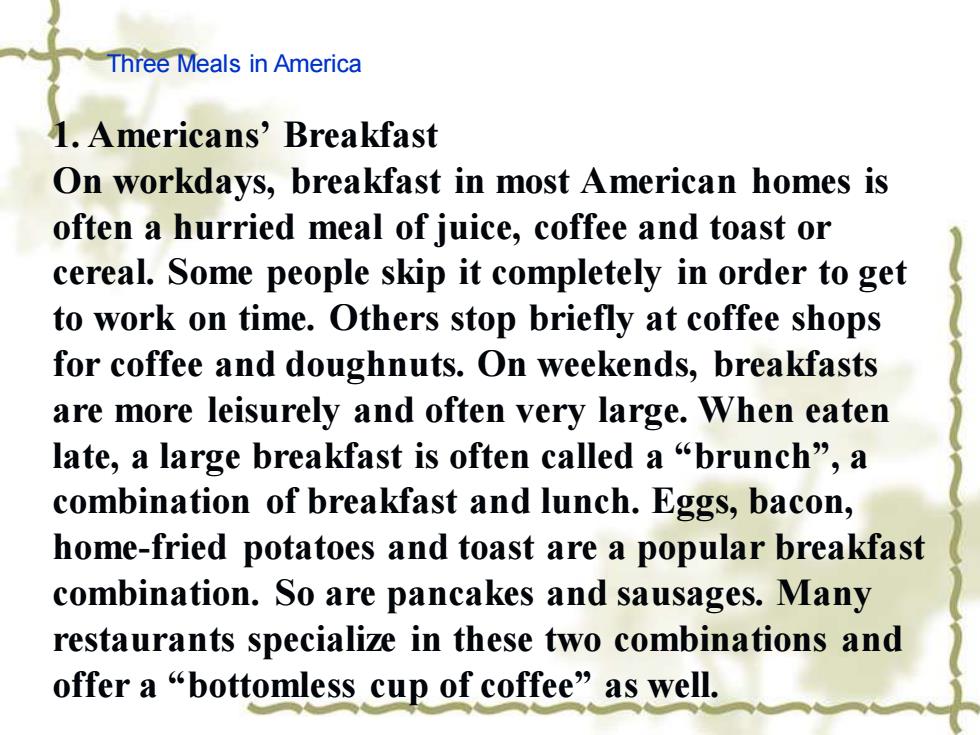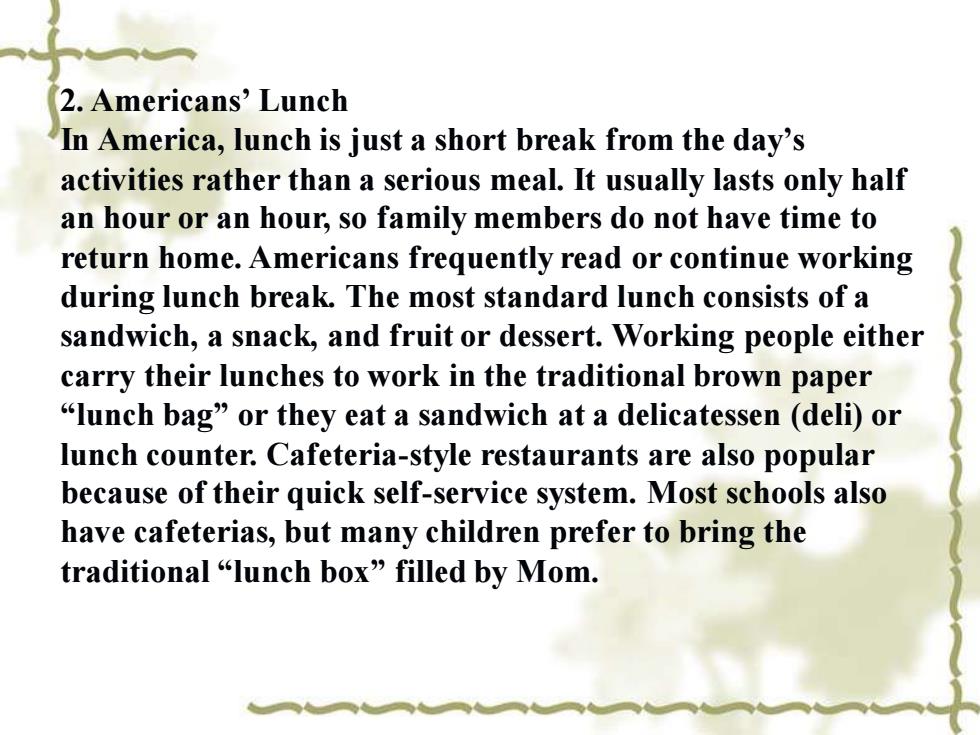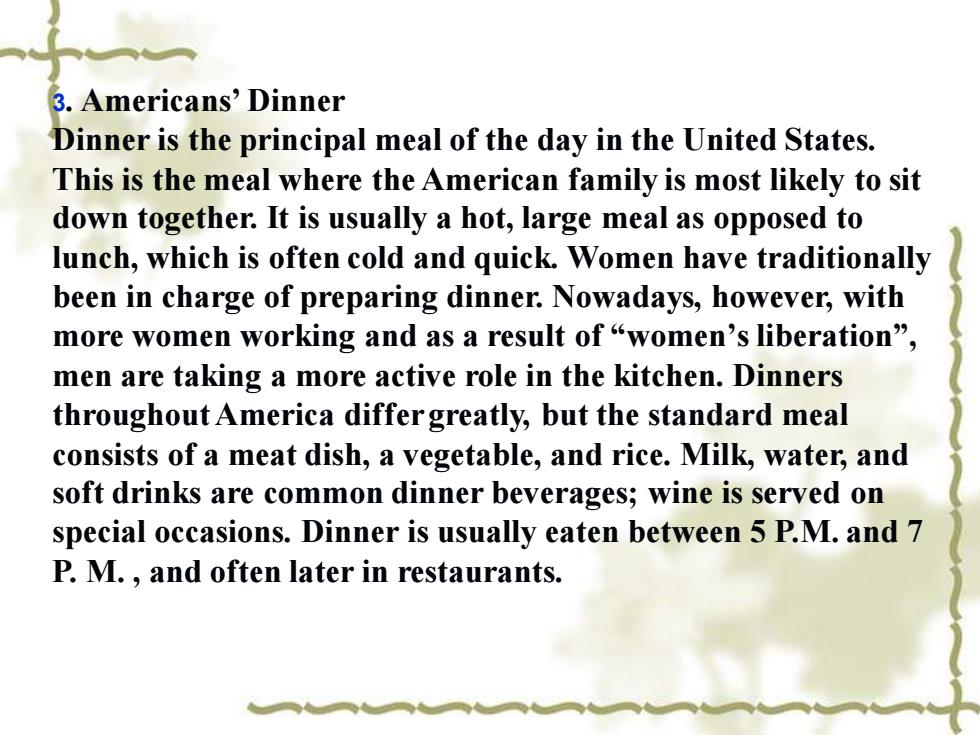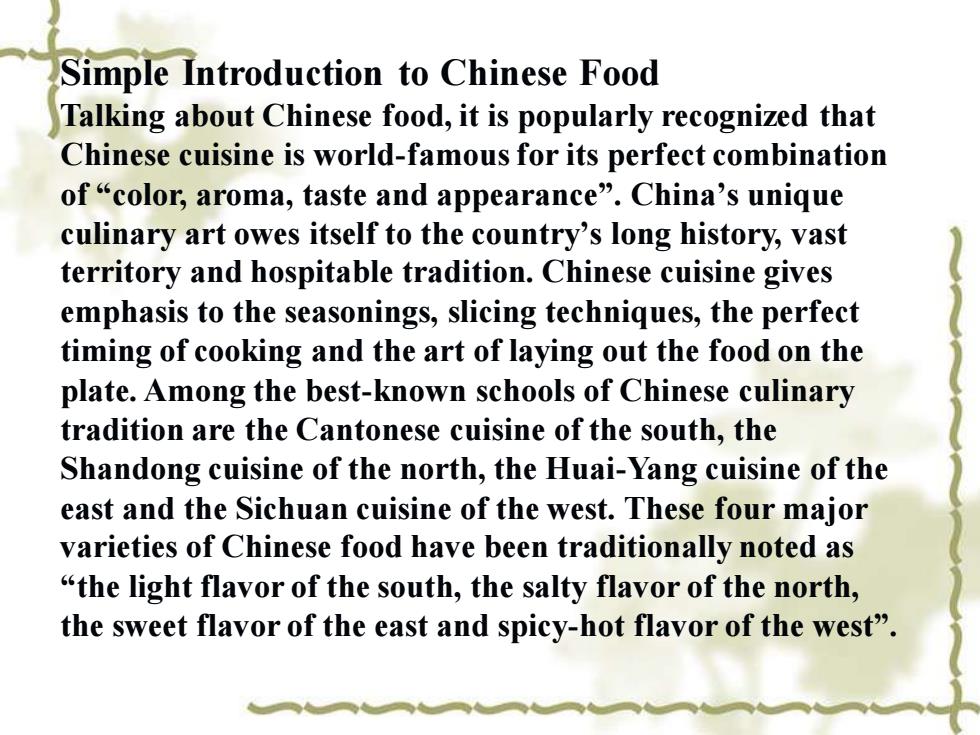
ThreeMealsinAmerical.Americans' BreakfastOn workdays, breakfast in most American homes isoften a hurried meal of juice, coffee and toast orcereal. Some people skip it completely in order to getto work on time. Others stop briefly at coffee shopsfor coffee and doughnuts.On weekends,breakfastsare more leisurely and often very large.When eatenlate, a large breakfast is often called a “brunch", acombination of breakfast and lunch. Eggs, bacon.home-fried potatoes and toast are a popular breakfastcombination. So are pancakes and sausages. Manyrestaurants specialize in these two combinations andoffera“bottomless cupof coffee"aswell
Three Meals in America 1. Americans’ Breakfast On workdays, breakfast in most American homes is often a hurried meal of juice, coffee and toast or cereal. Some people skip it completely in order to get to work on time. Others stop briefly at coffee shops for coffee and doughnuts. On weekends, breakfasts are more leisurely and often very large. When eaten late, a large breakfast is often called a “brunch”, a combination of breakfast and lunch. Eggs, bacon, home-fried potatoes and toast are a popular breakfast combination. So are pancakes and sausages. Many restaurants specialize in these two combinations and offer a “bottomless cup of coffee” as well

2.Americans'LunchIn America, lunch is just a short break from the day'sactivities rather than a serious meal. It usually lasts only halfan hour or an hour, so family members do not have time toreturn home. Americans frequently read or continue workingduring lunch break. The most standard lunch consists of asandwich, a snack, and fruit or dessert. Working people eithercarry their lunches to work in the traditional brown paper"lunch bag" or they eat a sandwich at a delicatessen (deli) orlunch counter. Cafeteria-style restaurants are also popularbecause of their quick self-service system. Most schools alsohave cafeterias, but many children prefer to bring thetraditional"lunch box" filled by Mom
2. Americans’ Lunch In America, lunch is just a short break from the day’s activities rather than a serious meal. It usually lasts only half an hour or an hour, so family members do not have time to return home. Americans frequently read or continue working during lunch break. The most standard lunch consists of a sandwich, a snack, and fruit or dessert. Working people either carry their lunches to work in the traditional brown paper “lunch bag” or they eat a sandwich at a delicatessen (deli) or lunch counter. Cafeteria-style restaurants are also popular because of their quick self-service system. Most schools also have cafeterias, but many children prefer to bring the traditional “lunch box” filled by Mom

3.Americans'DinnerDinner is the principal meal of the day in the United States.This is the meal where the American familyis most likely to sitdown together. It is usually a hot, large meal as opposed tolunch, which is often cold and guick. Women have traditionallybeen in charge of preparing dinner. Nowadays, however, withmore women working and as a result of “women's liberation'men are taking a more active role in the kitchen. DinnersthroughoutAmerica differgreatly, but the standard mealconsists of a meat dish, a vegetable, and rice. Milk, water, andsoft drinks are common dinner beverages; wine is served onspecial occasions.Dinner is usually eaten between 5 P.M. and 7P.M.and oftenlaterin restaurants
3. Americans’ Dinner Dinner is the principal meal of the day in the United States. This is the meal where the American family is most likely to sit down together. It is usually a hot, large meal as opposed to lunch, which is often cold and quick. Women have traditionally been in charge of preparing dinner. Nowadays, however, with more women working and as a result of “women’s liberation”, men are taking a more active role in the kitchen. Dinners throughout America differ greatly, but the standard meal consists of a meat dish, a vegetable, and rice. Milk, water, and soft drinks are common dinner beverages; wine is served on special occasions. Dinner is usually eaten between 5 P.M. and 7 P. M. , and often later in restaurants

Simple Introduction to Chinese FoodTalking about Chinese food, it is popularly recognized thatChinese cuisine is world-famous for its perfect combinationof “color, aroma, taste and appearance". China's uniqueculinary art owes itself to the country's long history, vastterritory and hospitable tradition. Chinese cuisine givesemphasis to the seasonings, slicing techniques, the perfecttiming of cooking and the art of laying out the food on theplate. Among the best-known schools of Chinese culinarytradition are the Cantonese cuisine of the south, theShandong cuisine of the north, the Huai-Yang cuisine of theeast and the Sichuan cuisine of the west. These four majorvarieties of Chinese food have been traditionallynoted asthe lightflavor of the south, the salty flavor of the north.the sweet flavor of the east and spicy-hot flavor of the west
Simple Introduction to Chinese Food Talking about Chinese food, it is popularly recognized that Chinese cuisine is world-famous for its perfect combination of “color, aroma, taste and appearance”. China’s unique culinary art owes itself to the country’s long history, vast territory and hospitable tradition. Chinese cuisine gives emphasis to the seasonings, slicing techniques, the perfect timing of cooking and the art of laying out the food on the plate. Among the best-known schools of Chinese culinary tradition are the Cantonese cuisine of the south, the Shandong cuisine of the north, the Huai-Yang cuisine of the east and the Sichuan cuisine of the west. These four major varieties of Chinese food have been traditionally noted as “the light flavor of the south, the salty flavor of the north, the sweet flavor of the east and spicy-hot flavor of the west

TeaAccording to legend tea has been known in China sinceabout 2 7o0 BC. For one thousand years it was amedicinal beverage obtained by boiling fresh leaves inwater, but around the 3rd century AD it became adaily drink, and tea cultivation and processing beganThe first published account of methods of planting:processing, and drinking came in AD 350
Tea According to legend tea has been known in China since about 2 700 BC. For one thousand years it was a medicinal beverage obtained by boiling fresh leaves in water, but around the 3rd century AD it became a daily drink, and tea cultivation and processing began. The first published account of methods of planting, processing, and drinking came in AD 350